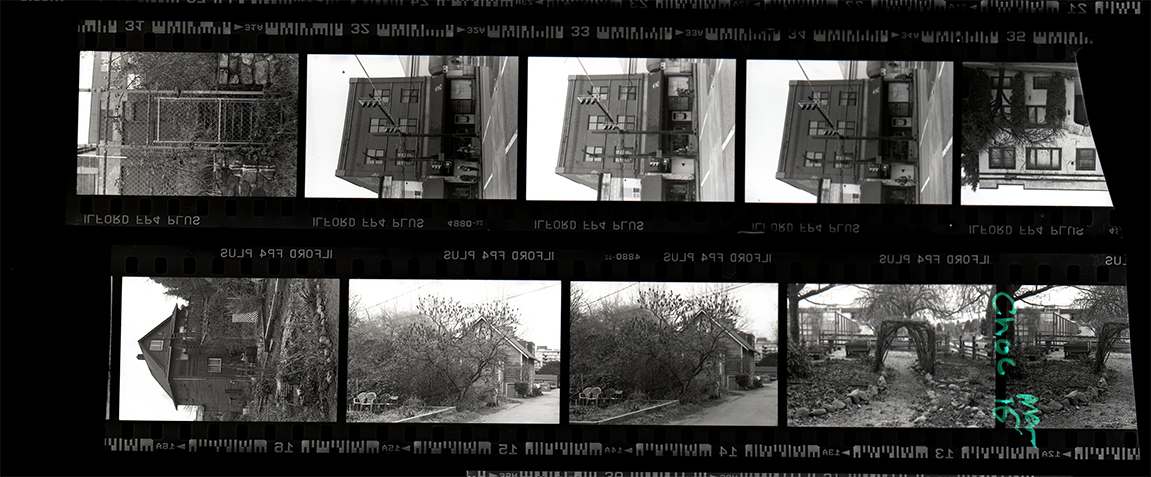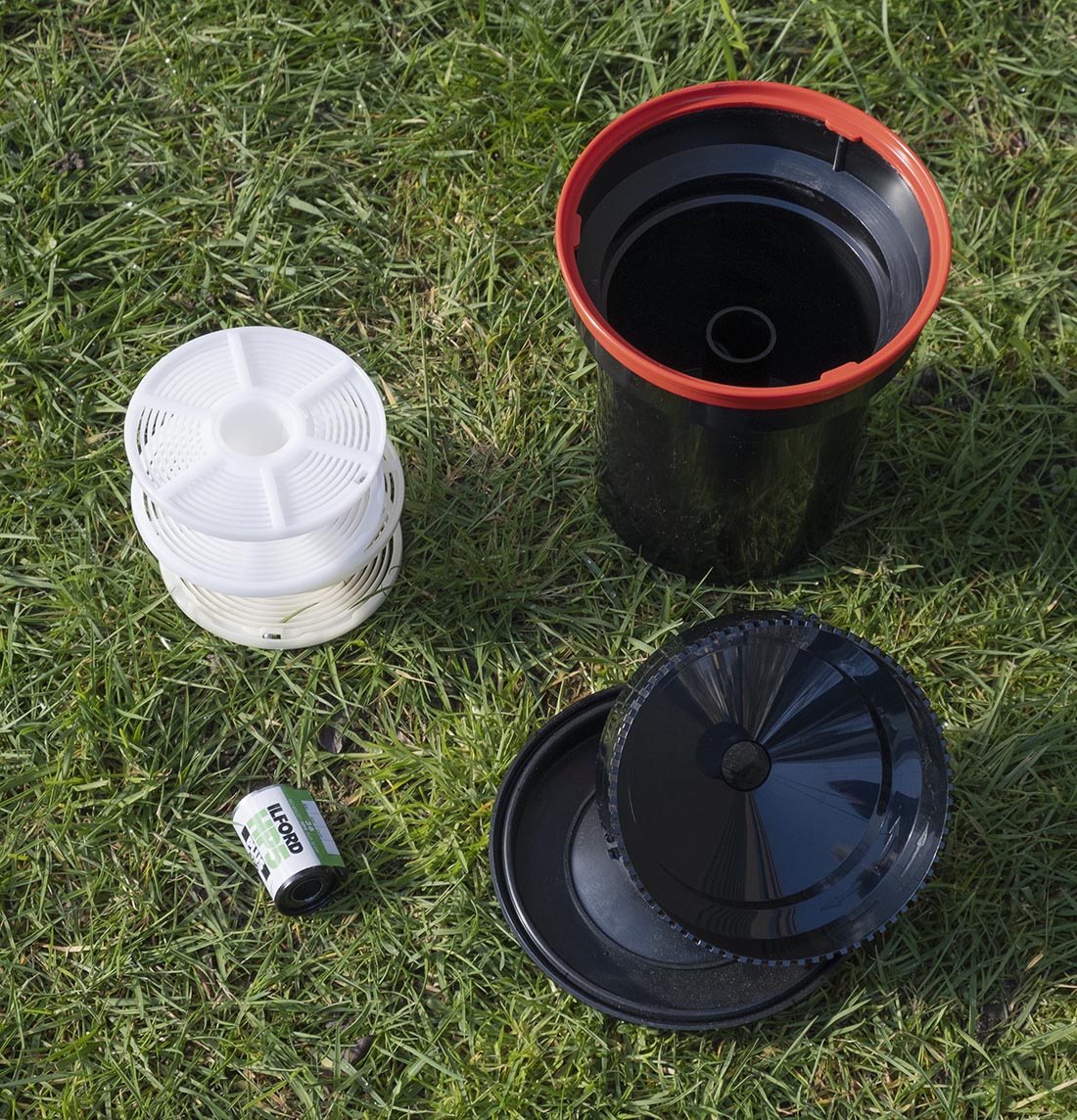Thinking about the environmental impact of my photographic practice led me to do some research on alternative developers. Caffenol (developer made with coffee) has been around for quite a while and there are many versions of the recipe. This photographer from Copenhagen has published his recipe on his blog – https://www.peterbjerg.dk/blog/eco2 I haven’t tried it yet, but will in the future. You can also find recipes on the Caffenol.org website https://www.caffenol.org/ and on many other websites. There are quite a few people all over the world who are working with plant based developers.
I was inspired by a recipe for spruce needle developer that I saw somewhere, and then I found more on the Alt Photo site using different plant material. https://www.alternativephotography.com/herbal-developers/. I substituted spruce for the arnica and developed some Kentmere 100 film. My first few rolls came out very fogged and dark with little image density, but one can’t be discouraged by poor results! After working with historic processes for most of my photographic practice, I am familiar with the patience and perseverance required to get good results. I adjusted the recipe by using less washing soda, and my next spruce needle developed roll looked quite lovely in my eyes! I also discovered that if I reused the developer, the second roll came out with less fog.
I knew that other plant material could be substituted for spruce, it is the same basic recipe as caffenol after all. One evening when I had made myself a delicious cup of chocolate tea from cacao husks steeped in water, and then was distracted by something so that my tea got cold, I thought I’d try that as a developer. To my amazement, it worked very well! Less fog than the spruce needle developer and good image density. It also smelled like chocolate! Since then, I have developed several rolls in the chocolate developer and am becoming more particular about negative quality, mid-tone density, and details in the shadows. I’ve been experimenting with changing the development time, using anywhere between 10 and 20 minutes, and temperature. I’ve also been re-using the developer to see how it changes the image density and grain after a few uses.
This is just the beginning of my testing, and will share more results after I have some more definitive answers. I will be trying different trees, plants and of course, more chocolate. For now, here is the recipe I started with so you can experiment with developers yourself. Remember to keep good notes and only change one variable at a time or you won’t know what it was that made that negative look fogged, or maybe look fabulous.
I haven’t gone into the technical details about chemical reactions and the reduction of exposed silver halides into metallic silver, there is quite a lot written about this already, but if you are a chemist, you may find this very useful information to look up. If you know what reactions are happening and what each chemical contributes to the process, you can make adjustments that affect the quality of the negative and be able to better predict outcomes.
Chocolate Film Developer
20g washing soda (sodium carbonate, not baking soda)
10g powdered vitamin C (ascorbic acid)
Cacao husk (or other plant material) to make 500ml chocolate tea (use a typical amount of husks you might make tea to drink)
Tea can be made by pouring boiling water over the plant material and letting it steep for several hours or overnight. Filter after steeping.
Mix the washing soda into the tea, let it dissolve completely.
Mix the ascorbic acid into the tea, use a larger container to mix in as it may fizz up at this point.
Once it has completely dissolved it is ready to use.
I began by developing a roll of Kentmere 100 for 15 minutes at 26C
Stop, fix and wash as usual. If you are looking for a more environmentally friendly solution to the rest of the process, try using stop and fix from Flic Film, and always make sure to recycle your used fixer!
**Please note that while this is a less toxic developer, it still needs to be treated as a chemical, and all film processing should NOT be done in your kitchen. Label all bottles carefully and keep away from children and pets.
If you are looking for a source of cacao husks, I found mine at Cocoaro, a wonderful shop that makes chocolate from ethically sourced beans – cocoaro.ca. The tea isn’t on their website, but they do have it in the shop. It makes a nice developer, and also a good cup of tea (without the added chemicals of course). They also make delicious chocolate, and are in Port Moody (Update: They are now in New Westminster) so if you don’t live out that way you can make a nice afternoon of sourcing some for yourself.
Here are a few scans of some chocolate developed negatives.
I hope this has inspired some of you to try plant developers yourself! Share some of your recipes and results here. The sustainable photo community works best when we exchange ideas and good energy!
I also decided to try enlarging one of the images so I could develop the paper in the same chocolate developer. It is very slow to come up in the tray, but after a 5 min development, I got a very nice image. The cocolate stains the paper slightly, giving a warm tone print. This is something I will be doing further experiments on as well.
The print on the left was developed in a chocolate tea developer, the print on the right was developed in Ilford Multigrade paper developer. Both were printed on Ilford RC Satin paper











2 replies on “Experiments in Developing Film with Chocolate”
Jaime Adams
I’m so glad to see this post! I’ve been experimenting with plant developers and my negatives come out extremely dense/dark. The recipes that I have seen call for more than twice the amount of washing soda than yours, as well as more vitamin c. Do you think the washing soda is causing the thick negatives? Is it overdeveloping or something else? I also use 30c rather than your 26c and am wondering what kind of a difference the temperature makes.
I started using plant developers right away due to being highly allergic to regular developers so my knowledge of an ideal negative is slim and I’d love help troubleshooting. I usually use Ilford HP5.
Kathy K
Hi Jaime, Thank you for your comments. I’m happy to hear you are trying plant developers too. I also started out with a recipe that used much more washing soda and found my negatives to be dense, and fogged. Are the edges of the film dark too or just the image area? If the edges are dark then it is also fogging that you see. The temperature will definitely affect the image, warmer developer is going to be more active, which will increase density. Please feel free to e-mail me with more questions! I’d love to hear what is working for you too.
Comments are closed.